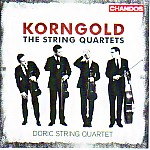There’s very little competition for this music, which is a shame because these are excellent quartets. It’s really very remarkable how Korngold uses timbre to keep the busy textures clear and prevent his often chromatic harmony from turning into sludge. The main competition comes from the Flesch Quartet on ASV, so-so performances spread over two discs because they include the string Sextet as well. In general, the Doric Quartet offers livelier, more colorful, more accurate performances. To give just one example: the score of the Second quartet lists the work’s duration at an optimistically fast 18 minutes. Flesch takes 25, while the Doric clocks in at an ideal 21 minutes.
These quartets are quite difficult to play, the first especially, which features frequent changes of tempo, often within a few bars. The Doric players handle all of these with astonishing ease and naturalness. There are a couple of points, as at figure 3 in the Second quartet’s first movement, where the group slows down a bit in anticipation of Korngold’s marking (his “Un poco più tranquillo” doesn’t arrive until seven bars later), but if this is a fault, it’s a vanishingly minor one.
Otherwise, you can only applaud the group’s tonal richness, immaculate intonation, and a stylishness that never turns tacky (excellent application of portamento). First violinist Alex Redington deserves particular mention for handling his vibrato-less “ohne Ausdruck” moments (figure 7 in the First quartet’s first movement, for example) with the right expressive point while never letting his tone turn just plain ugly (“period” performers take note). Violist Simon Tandree also features a particularly attractive timbre in his many solo licks. Korngold asks for many “special effects”, including harmonics, col legno, open strings, muting, and lots of pizzicato; all of these are rendered with consistent musicality and are beautifully integrated into the ensemble texture.
Excellent sonics complement this obvious first choice for this music. If you don’t know these pieces, you should. There’s much more to Korngold than you might think–check out the wonderfully spiky scherzo in the Third quartet for a particularly bracing “fact check” on his theoretically unabashedly late-Romantic style. One final note for score collectors: all three works are available from Schott, the first two quartets in convenient study format, the Third only as a score and parts. An important release for chamber music devotees, and a terrific example of first-rate quartet playing. [12/6/2010]
































